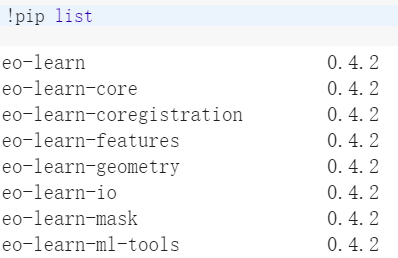I am trying to use the example land cover classification code without modification from https://github.com/sentinel-hub/eo-learn/blob/934b4e6328706b4d44905d54e58b5fa7dc267ec1/examples/land-cover-map/SI_LULC_pipeline.ipynb. However, I found that only 5 bands were returned when 6 bands were requested to return, which is also inconsistent with the result from the example code. When I use the code for another area of interest, it is in the same situation. I am confused about this.
The result from the example code, where BANDS are of 6 bands:
EOPatch(
data: {
BANDS: numpy.ndarray(shape=(69, 337, 333, 6), dtype=float32)
CLP: numpy.ndarray(shape=(69, 337, 333, 1), dtype=float32)
NDVI: numpy.ndarray(shape=(69, 337, 333, 1), dtype=float32)
NDWI: numpy.ndarray(shape=(69, 337, 333, 1), dtype=float32)
NORM: numpy.ndarray(shape=(69, 337, 333, 1), dtype=float32)
}
mask: {
CLM: numpy.ndarray(shape=(69, 337, 333, 1), dtype=uint8)
IS_DATA: numpy.ndarray(shape=(69, 337, 333, 1), dtype=uint8)
IS_VALID: numpy.ndarray(shape=(69, 337, 333, 1), dtype=bool)
}
scalar: {}
label: {}
vector: {}
data_timeless: {}
mask_timeless: {
LULC: numpy.ndarray(shape=(337, 333, 1), dtype=uint8)
VALID_COUNT: numpy.ndarray(shape=(337, 333, 1), dtype=int64)
}
scalar_timeless: {}
label_timeless: {}
vector_timeless: {}
meta_info: {
maxcc: 0.8
service_type: 'wcs'
size_x: '10m'
size_y: '10m'
time_difference: datetime.timedelta(-1, 86399)
time_interval: <class 'list'>, length=2
}
bbox: BBox(((510157.61722214246, 5122327.229129893), (513489.214628833, 5125693.036780571)), crs=EPSG:32633)
timestamp: <class 'list'>, length=69
)
and result from our execution, with BANDS of 5 bands:
EOPatch(
data: {
BANDS: numpy.ndarray(shape=(69, 337, 333, 5), dtype=float32)
CLP: numpy.ndarray(shape=(69, 337, 333, 1), dtype=float32)
NDVI: numpy.ndarray(shape=(69, 337, 333, 1), dtype=float32)
NDWI: numpy.ndarray(shape=(69, 337, 333, 1), dtype=float32)
NORM: numpy.ndarray(shape=(69, 337, 333, 1), dtype=float32)
}
mask: {
CLM: numpy.ndarray(shape=(69, 337, 333, 1), dtype=bool)
IS_DATA: numpy.ndarray(shape=(69, 337, 333, 1), dtype=bool)
IS_VALID: numpy.ndarray(shape=(69, 337, 333, 1), dtype=bool)
}
scalar: {}
label: {}
vector: {}
data_timeless: {}
mask_timeless: {
LULC: numpy.ndarray(shape=(337, 333, 1), dtype=uint8)
VALID_COUNT: numpy.ndarray(shape=(337, 333, 1), dtype=int64)
}
scalar_timeless: {}
label_timeless: {}
vector_timeless: {}
meta_info: {
maxcc: 0.8
service_type: 'wcs'
size_x: '10m'
size_y: '10m'
time_difference: datetime.timedelta(-1, 86399)
time_interval: ['2017-01-01', '2017-12-31']
}
bbox: BBox(((513489.214628833, 5122327.229129893), (516820.8120355235, 5125693.036780571)), crs=EPSG:32633)
timestamp: [datetime.datetime(2017, 1, 1, 10, 4, 7), ..., datetime.datetime(2017, 12, 29, 9, 57, 10)], length=69
)